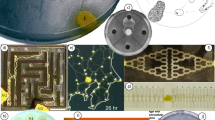Abstract
In study of collective behavior, though collective foraging behavior against surroundings is one of the most vivid examples about how animal group responses to external environment, relative experiment is rare. In this paper, we show an experiment with respect to collective foraging using a swarm of soldier crabs Mictyris guinotae, which live in the tideland and can form large swarms. We recorded the behaviors of soldier crab swarms with 10, 20, 30, 40 individuals in experimental arenas. Thanks to markers attached to crabs’ shells and image-processing software, we obtained time series of individuals’ position during 30 min. As a consequence, we found the soldier crabs form densely swarm to some extent in the ring-shaped experimental arena. Moreover, when we calculated the time between direction changes of the swarm, we found that it followed power-law distribution, containing very long moves. Such movement pattern is frequently found in foraging behavior of single animals. Our results, therefore, suggest that collective swarms show a type of foraging behavior as a single group.






Similar content being viewed by others
References
Procaccini A et al (2011) Propagating waves in starling, Sturnus vulgaris, flocks under predation. Anim Behav 82:759–765
Cavagnaa A et al (2014) Information transfer and behavioural inertia in starling flocks. Nat Phys 10:691–696
Buhl J, Sumpter DJT, Couzin ID, Hale JJ, Despland E, Miller ER, Simpson SJ (2006) From disorder to order in marching locusts. Science 312:1402–1406
Bradshaw C, Scoffin TP (1999) Factors limiting distribution and activity patterns of the soldier crab Dotilla myctiroides in Phuket, South Thailand. Mar Biol 135:83–87
Shih JT (1995) Population-densities and annual activities of Mictyris brevidactylus (Stimpson, 1858) in the Tanshui mangrove swamp of northern Taiwan. Zool Stud 34:96–105
Davie PJF, Shih HT, Chan BKK (2010) A new species of Mictyris (Decapoda, Brachyura, Mictyridae) from the Ryukyu Island, Japan. Crustac Monogr 11:83–105
Takeda S, Murai M (2004) Microhabitat use by the soldier crab Mictyris brevidactylus (Brachyura: Mictyridae): interchangeability of surface and subsurface feeding through burrow structure alteration. J Crustac Biol 24:327–339
Ravary F, Lecoutey E, Kaminski G, Châline N, Jaisson P (2007) Individual experience alone can generate lasting division of labor in ants. Curr Biol 17:1308–1312
Dornhaus A, Holley JA, Franks NR (2009) Larger colonies do not have more specialized workers in the ant Temnothorax albipennis. Behav Ecol 20:922–929
Edwards AM, Phillips RA, Watkins NW, Freeman MP, Murphy EJ et al (2007) Revisiting Lévy flight search patterns of wandering albatrosses, bumblebees and deer. Nature 449:1044–1049
Viswanathan GM, Raposo EP, da Luz MGE (2008) Lévy flights and superdiffusion in random search: the biological encounters context. Phys Life Rev 5:133–162
Murakami H et al (2014) Emergent runaway into an avoidance area in a swarm of soldier crabs. PLoS ONE 9(5):e97870. doi:10.1371/journal.pone.0097870
Yates CA, Erban R, Escudero C, Couzin ID, Buhl J, Kevrekidis IG et al (2009) Inherent noise can facilitate coherence in collective swarm motion. Proc Natl Acad Sci USA 106:5464–5469
Cavagna A, Queirós SMD, Giardina I, Stefanini F, Viale M (2013) Diffusion of individual birds in starling flocks. Proc R Soc B 280:1471–2954
Niizato T et al (2014) Emergence of the scale-invariant proportion in a flock from the metric-topological interaction. Biosystems 119:62–68
Author information
Authors and Affiliations
Corresponding author
About this article
Cite this article
Murakami, H., Tomaru, T., Niizato, T. et al. Collective behavior of soldier crab swarm in both ring- and round-shaped arenas. Artif Life Robotics 20, 315–319 (2015). https://doi.org/10.1007/s10015-015-0232-y
Received:
Accepted:
Published:
Issue Date:
DOI: https://doi.org/10.1007/s10015-015-0232-y




